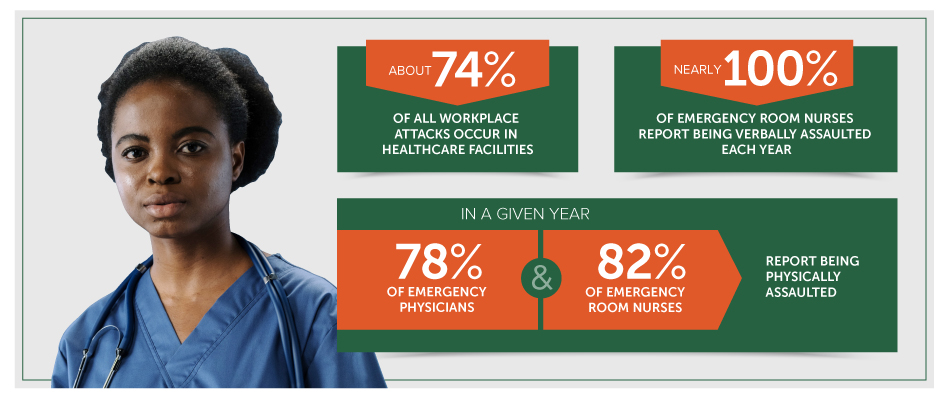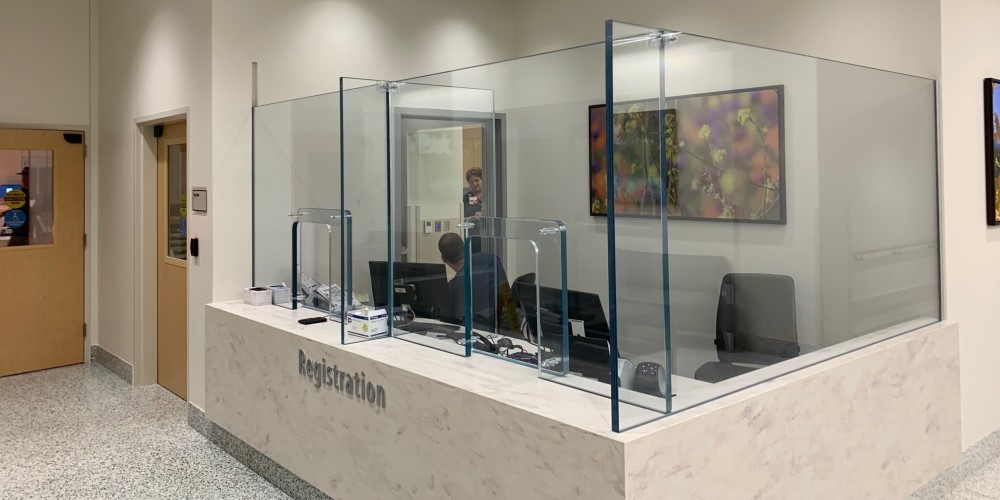Hospital security is extremely challenging—but extremely important. According to Pew Research, nearly 20% of healthcare workers left the field during the COVID-19 pandemic, straining an already understaffed system. Healthcare professionals accept that they have inherently stressful workplaces. But, at the very least, they should be safe and secure workplaces.
But that is not the case, and it is getting worse. A 2016 study published in the New England Journal of Medicine found that, in a given year, 100% of ER nurses reported experiencing verbal assault and 82.1% reported physical assault. A similar study among emergency department physicians found that 70% reported having been assaulted. National Nurses United notes that, since the start of the pandemic, its members have reported a roughly 20% increase in workplace violence. (By contrast, according to the FBI, about 12% of law enforcement officers were assaulted in 2019.)
In part, this is due to the fact that they are classic "soft targets": Busy locations with many access points and lots of people, often congregated in crowded halls or waiting areas. The nature of their services mean they must be open around-the-clock and keep people moving quickly and freely from place to place. Many people means lots of valuables—for those looking to take advantage of those under duress—as well as many opportunities for misunderstandings, conflicts, or stress to boil over into violence.

Hospital Security Solutions
Hospitals have traditionally addressed this with security guards or a law enforcement presence. But, given the nature of hospital operations, that often amounts to little more than bouncers: a stern front to deter misbehavior and strong arms to address violence once it has already happened.
“In most situations—a school, a government office—you secure the main entrance," explains Jim Richards, CEO of Total Security Solutions, a leading provider of hospital security solutions and ballistic barriers. "Once you've checked someone in and are sure they aren't a threat, they are free to go about their business anywhere inside. But that doesn't work in a hospital. Not only are there often several 'main' entrances, but in most cases you need to let traffic in quickly. We all know, in a big hospital, that area is busier than Grand Central Station, day and night." Any sort of reasonably secure checkpoint solution is simply not an option.
Instead, Jim advises medical care providers to adopt a "systems approach" to hospital security. This uses the structure of healthcare operations to its advantage and mimics the "defense in depth" approach used in cybersecurity. Instead of exclusively reacting to breaches after they have begun, a systems approach prevents breaches whenever possible and minimizes them when they occur.
"If you think about a hospital, it’s already broken into smaller units; it’s not a one-stop shop. Each department has its reception people, its desk, and a set of doors. That might be for cardiology, for radiation, for gastro. The right approach is to secure each of these independently. This both protects patients and staff in that unit, and creates containment. This minimizes the impact if someone gets violent, protecting others from becoming targets of the attack and denying the attacker paths for evading capture."
The Systems Approach to Hospital Security
Although every hospital is unique, most individual departments within the hospital have three core elements:
- Waiting area
- Reception desk
- Consultation or examination rooms
While the waiting area may be either before or behind the reception desk, the consultation/examination rooms themselves are always behind closed doors.
This layout creates an excellent opportunity for increased security by reinforcing the reception area with bullet-resistant glass and fiberglass and swapping the existing doors for access-control bullet resistant doors. Currently, most healthcare facilities are opting for Level 3 or 4 ballistic materials for such barrier systems. (Level 3 and 4 materials will stop multiple shots from any sort of handgun. In the case of Level 4 windows and doors, staff are also protected from high-powered rifles, some blasts, and prolonged attempts at forced-entry).
Custom Hospital Security Barrier Solutions
“Everybody wants to try to add layers,” Jim explains. "You have access control, cameras, and adding that barrier to protect the receptionist at the receiving area, where violence and frustration often break out or spread. But you can't just add measures haphazardly."
When security measures aren't thoughtfully deployed, they get in the way of operations. Then the people you are trying to protect—doctors, nurses, and other healthcare providers—become the people most likely to compromise security:
Doors that should remain closed are propped open, people are waved through rather than checked in, staff come out from behind barriers to give visitors their badges or place wristbands on patients, and so on.
This is why TSS places a premium on understanding day-to-day operations prior to designing a barrier for that facility.
"Passers are an excellent example," Jim explains. "In many cases, if they just need to scan IDs or pass papers, a traditional deal tray is fine for paper. But in a hospital, often they need to pass a clipboard or a medical sample, something with more awkward dimensions or that requires special handling. We've designed many different custom solutions for that, so what they have works well and looks good—not like you took a solution from a 24-hour gas station and bolted it onto a hospital countertop. We've even made custom hinged doors in bullet resistant acrylic or polycarbonate, so patients could reach through to have a wristband secured without compromising staff security. Whatever that department needs to operate safely, we can do."
Increasing Security Throughout the Healthcare System
Hospitals—while clearly a major focus for security—are far from the only part of the healthcare system that needs to enhance safety. According to the Occupational Safety and Health Administration (OSHA), roughly 75% of all workplace assaults happen in either a health care or social service settings, such as clinics, mental health facilities, counseling offices, and the like. The U.S. Bureau of Labor Statistics notes that healthcare workers and those who work in "social assistance" are five times more likely to suffer violence in the workplace.
“We do all kinds of offices," Jim explains. "Pharmacies, therapists, clinics of all kinds. Really, anywhere that there is a person sitting with another person across the desk, and they need protection. In essence, it’s no different than a lawyer’s office or a courthouse or even a utility office: these are situations where people are stressed or desperate, or not thinking clearly, and emotions can run high. Meanwhile, the staff are doing these very important jobs, often under very strenuous working conditions. That's not a great recipe for anyone's health. Anything we can do to reduce that strain is going to mean better outcomes for everyone.”
We Protect Hospitals—and the People Inside
“We’re always trying to reduce the threat," Jim concludes. "We want employees to feel safe and secure. You get there by minimizing the impact of someone trying to take advantage or someone that’s upset or irritated or angry losing control. If there’s a good barrier and well thought-out access control in place, that eliminates some of those situations and reduces the likelihood or impact of all of them.”
To learn more about how to approach hospital and healthcare security, you can download TSS's free Healthcare Security Checklist. Ready to start a project, or have specific questions about healthcare security strategies? Contact TSS's ballistic security experts today.


